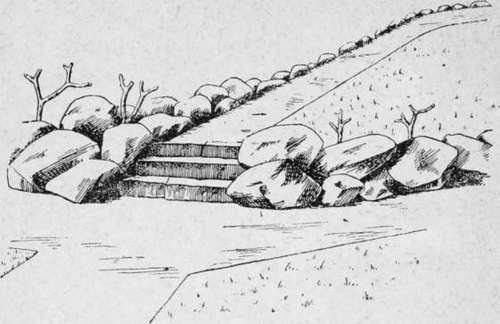Chapter XVIII. Daily Routine And Seasonable Work
Description
This section is from the book "Town Gardening", by Mary Hampden. Also available from Amazon: Town Gardening.
Chapter XVIII. Daily Routine And Seasonable Work
General Work For November, December And January
IMPROVE vacant soil by adding manure, if it is poor. Ground that is enough manured can often be made better for plant-life by forking in plenty of road-gritóroad sweepings without manure, taken from country roadsóor crushed brick-rubble if there are no rhododendrons, which could not bear with the lime therein. Obtain these ingredients from builders or horticultural providers.
The opening and closing of greenhouse windows and of frames will be a task for common sense to decide, as no hard and fast rules can guide. A brilliant winter's afternoon may allow air to be given freely, to the great benefit of plants; whereas on damp, foggy, airless days the walls and stones, etc., of conservatories become soaked if there is much ventilation.
Water all pot plants with tepid water only-No water should ever lie on floors in winter. If it is thought that a fernery has become overdried by sunshine or artificial heat, standing a pail of water in it for some hours will soon moisten the atmosphere. Syringings are seldom needed now in open suburbs, but must be given fairly often, when frost is not present, in the centre of towns. This should be done in mornings, and if suitable air can be admitted to dry the place, well and good; otherwise windows should be closed and a small lamp, with talc chimney that will not crack, be stood inside for some hours. Use water that is not ice-cold.
Dead leaves have to be frequently swept up; if left on lawns or paths they make them slimy.
Uneven parts of walks should be remedied by lifting bricks, tiles, or flagstones and putting crushed mortar or cement beneath, and by scratching up the surface of gravel, filling in hollows with fresh gravel, watering and rolling often.
Cinder-ashes should be banked up against the wooden sides of frames.
Burn up, or otherwise get quite rid of, all decaying vegetation. Cut down hardy plants to within six inches of the soil. Be sure that mildewed rose boughs are all destroyed.
Keep the outside of the greenhouse glass well washed, as every bit of sun heat is of value.
See that all pots of growing plants are cleaned, by scraping or careful washing, on suitable days.
Mulch many borders, shrubberies, rose-beds, etc.
Water plants in mornings, not evenings. Continue to swreep and roll lawns. Prune straggly oleanders into shape.
Special Work For November
This is one of the chief bulb-planting months, so instructions already supplied should be carried out for the improvement of gardens, window-boxes, urns, etc.
Remove all suckers from the roots of lilac bushes. No pruning must be done, however, or there will be no flowers next year. This applies also to the mock orange (Syringa or Philadelphus) and to most flowering shrubs, which ought only to be cut back after they have bloomed.
Clean any oil-stoves that are used.
Arrange any coverings of mats, linen, or paper that may be needed to shelter plants from frost.
Lift all dahlias, bedding plants, etc.
Wrap up in sacking, yuccas, lemon verbenas, or other delicate plants that are in the open.
Continue to pot bulbs for the house.
Mow grass in the first week of the month, weather permitting, for the last time.
Special Work For December
There is not much to do, except maintain good order, hoe, remove dead foliage, attend to safeguarding from the cold.
This is, however, an excellent month in which to build rockeries, make different terrace levels, reached by wooden, beaten-earth, brick, or pavement steps, in readiness for March plantings.

A Hint how to Arrange Steps, Boulders, and Rockery.
Special Work For January
Prick over the soil among bulbs in beds, not going down more than half an inch, and avoiding the bulbs, of course. Add more coco-nut fibre refuse covering, if necessary; or, if there is none of this used, strew on a very little fresh loam or leaf-mould.
Prick over the surface soil of pot, box, and tub plants. Top-dress as above.
Use tepid water for delicate plants.
Mulch among clumps of hardy ferns, using equal parts of old manure, loam, and road-grit. The dead fronds should not be removed yet, as they serve to shelter new fronds that are starting below.
Hoe borders and beds after hard frosts have broken up.
If any shrubs or plants look badly frost-bitten; tie light canvas or newspapers over them, then they will be thawed sooner. Remove these as soon as the work is done.
Strew ashes from vegetable fires over the best beds and borders.
Virginia creepers may be pruned back.
Strew greenhouse or frame floors with borax to banish ants and wood-lice.
Fill up crevices in wood or brick with Portland cement, adding a very little glue to the water used.
Continue to:
